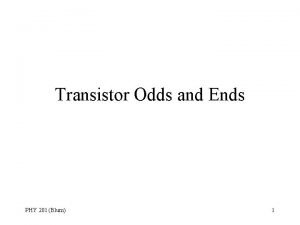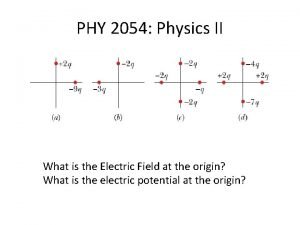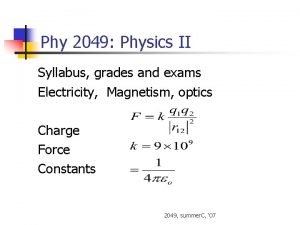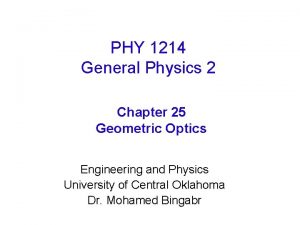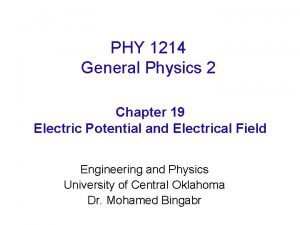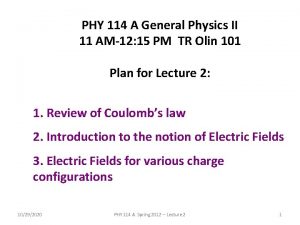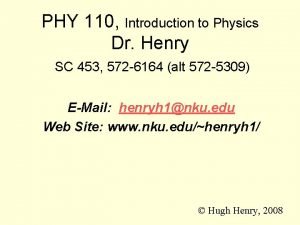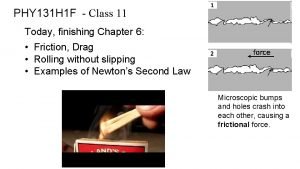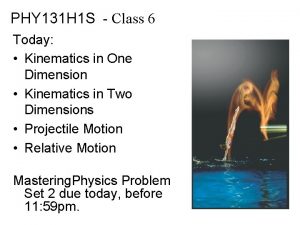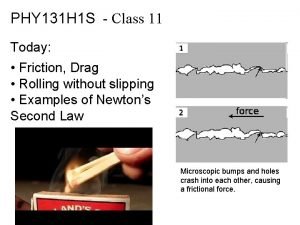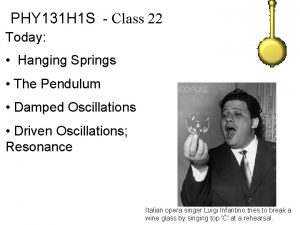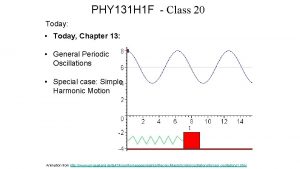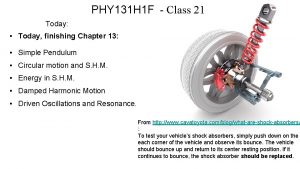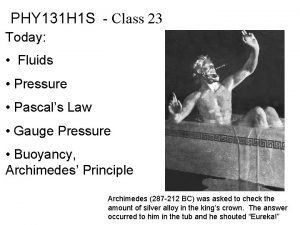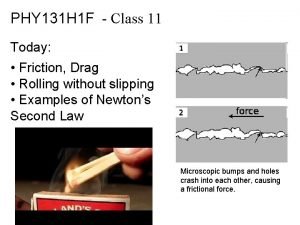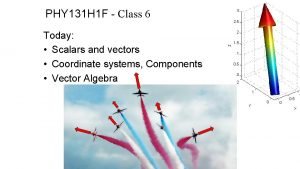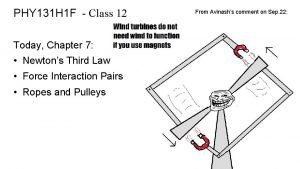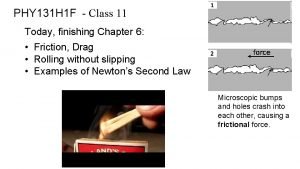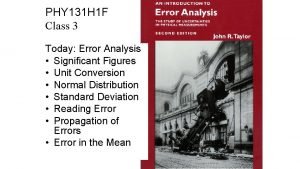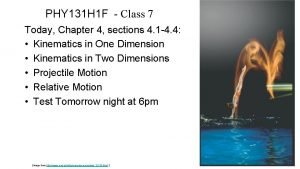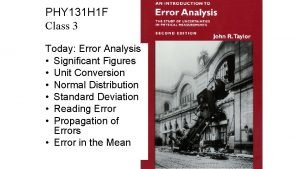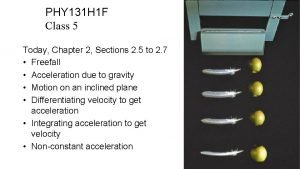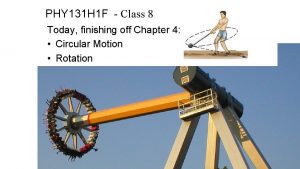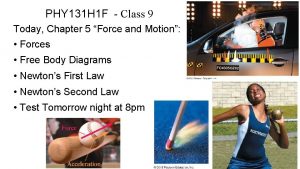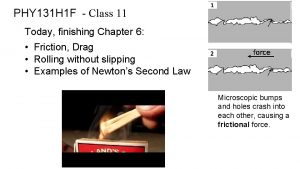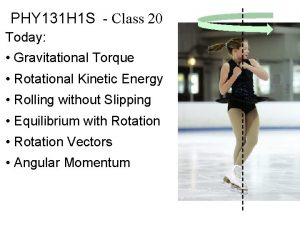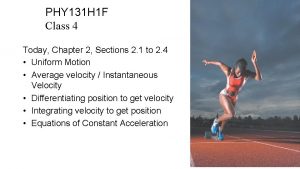PHY 131 H 1 F Class 23 Today


























- Slides: 26

PHY 131 H 1 F - Class 23 Today: • Sound Wave Intensity and the decibel system • Wave Interference: The Principle of Superposition • Constructive and Destructive Interference • Beats • Reflection and Refraction • Standing Waves • Musical Instruments

Wave intensity • The intensity of a wave is the average power it carries per unit area. • If the waves spread out uniformly in all directions and no energy is absorbed, the intensity I at any distance r from a wave source is inversely proportional to r 2.

Power and Intensity § When plane waves of power P impinge on area a, we define the intensity I to be:

Example 20. 9. A laser pointer emits 1. 0 m. W of light power into a 1. 0 mm diameter laser beam. What is the intensity of the laser beam?

Intensity of Spherical Waves § If a source of spherical waves radiates uniformly in all directions, then the power at distance r is spread uniformly over the surface of a sphere of radius r. § The intensity of a uniform spherical wave is:

Intensity and Decibels § Human hearing spans an extremely wide range of intensities, from the threshold of hearing at 1 × 10 12 W/m 2 (at midrange frequencies) to the threshold of pain at 10 W/m 2. § If we want to make a scale of loudness, it’s convenient and logical to place the zero of our scale at the threshold of hearing. § To do so, we define the sound intensity level, expressed in decibels (d. B), as: where I 0 = 1 10 12 W/m 2.

Sound Intensity Levels – Representative Values Source Military jet aircraft 30 m away Threshold of pain Elevated train Busy street traffic Quiet radio in home Average whisper Threshold of hearing at 1000 Hz Sound Intensity Level, β (d. B) Intensity, I (W/m 2) 140 102 120 90 70 40 20 0 1 10− 3 10− 5 10− 8 10− 10 10− 12

Learning Catalytics Question • A sound level of 10 decibels has 10 times more intensity than a sound level of zero decibels. • A sound level of 20 decibels has ___ times more intensity than a sound level of zero decibels. A. 10 B. 20 C. 50 D. 100 E. 200

Learning Catalytics Question • When you turn up the volume on your ipod, the sound originally entering your ears at 50 decibels is boosted to 80 decibels. By what factor is the intensity of the sound has increased? A. 1 (no increase) B. 30 C. 100 D. 300 E. 1000

Waves in Two and Three Dimensions The Principle of Superposition If two or more waves combine at a given point, the resulting disturbance is the sum of the disturbances of the individual waves.

Wave Interference • The pattern resulting from the superposition of two waves is called interference. Interference can be • constructive, meaning the disturbances add to make a resultant wave of larger amplitude, or • destructive, meaning the disturbances cancel, making a resultant wave of smaller amplitude.

Beats • Periodic variations in the loudness of sound due to interference • Occur when two waves of similar, but not equal frequencies are superposed. • Provide a comparison of frequencies • Frequency of beats is equal to the difference between the frequencies of the two waves. [image from http: //hyperphysics. phy-astr. gsu. edu/hbase/sound/beat. html ]

Beats • Applications – Piano tuning by listening to the disappearance of beats from a known frequency and a piano key – Tuning instruments in an orchestra by listening for beats between instruments and piano tone

Beats § The amplitude is slowly modulated with a frequency fmod = (f 1−f 2)/2 (red-dashed line) § Beats are heard at fbeat = 2 fmod = f 1−f 2

Preclass question from this morning The tension in each of two strings is adjusted so that both vibrate at exactly 666 Hz. The tension in one of the strings is then increased slightly. As a result, six beats per second are heard when both strings vibrate. What is the new frequency of the string that was tightened?

Standing Waves on a String Reflections at the ends of the string cause waves of equal amplitude and wavelength to travel in opposite directions along the string, which results in a standing wave.

The Mathematics of Standing Waves According to the principle of superposition, the net displacement of a medium when waves with displacements DR and DL are present is We can simplify this by using a trigonometric identity, and arrive at: where For a standing wave, the pattern is not propagating!

Quick. Check 21. 3 Learning Catalytics Question What is the wavelength of this standing wave? A. B. C. D. E. 0. 25 m. 0. 5 m. 1. 0 m. 2. 0 m. Standing waves don’t have a wavelength.

Node Spacing on a String

Standing Waves § Recall that the intensity of a wave is proportional to the square of the amplitude: I A 2. § Intensity is maximum at points of constructive interference and zero at points of destructive interference.

On a string of length L with fixed end points, Only oscillations with specific wavelengths are allowed. • • • m is called the mode number m = 1 is the “fundamental”. m = 2 is the “second harmonic”

Quick. Check 21. 4 Learning Catalytics Question What is the mode number of this standing wave?

Standing Waves on a String There are three things to note about the normal modes of a string: 1. m is the number of antinodes on the standing wave. 2. The fundamental mode, with m = 1, has λ 1 = 2 L. 3. The frequencies of the normal modes form a series: f 1, 2 f 1, 3 f 1, …These are also called harmonics. 2 f 1 is the “second harmonic”, 3 f 1 is the “third harmonic”, etc.

Musical Instruments § Instruments such as the harp, the piano, and the violin have strings fixed at the ends and tightened to create tension. § A disturbance generated on the string by plucking, striking, or bowing it creates a standing wave on the string. § The fundamental frequency is the musical note you hear when the string is sounded: where F is the tension in the string and is its linear density.

Preclass question from this morning

Class 24 (last class) is Tomorrow! § No Pre-Class Video or Pre-Class quiz § Homework 11 on Chapter 14 is for practice for the final exam – it’s not worth marks but I suggest you try it anyway for studying § If you haven’t done it, please check your utoronto email, respond to the course_evaluations email and evaluate us! § We are skipping section 14. 8 on Doppler Shift for this course. § Tomorrow my plan is finish up to section 14. 7, then I will do some course review and give some advice about the final exam. § Professor Wilson and I will be giving back-to-back “Exam Jam” sessions on Friday from 1: 00 -3: 00 pm in SS 2117. I have posted slides Exam Jam on my site with the other slides, and I will post any written notes from Exam Jam on the portal after Friday.
 Phy 131 past papers
Phy 131 past papers Phy 121 asu
Phy 121 asu Today there is class
Today there is class For todays meeting
For todays meeting Meeting objective
Meeting objective Characteristic of fingerprint
Characteristic of fingerprint Today's lesson or today lesson
Today's lesson or today lesson Today's lesson or today lesson
Today's lesson or today lesson Pa msu
Pa msu Great orthogonality theorem proof
Great orthogonality theorem proof Phy 221 msu
Phy 221 msu Phy theorem
Phy theorem Phy113
Phy113 Ddr phy architecture
Ddr phy architecture Phy 205
Phy 205 Eyephy
Eyephy Phy 2049
Phy 2049 Physics 2
Physics 2 Phy
Phy Phy
Phy Atm basics
Atm basics Phy
Phy Phy 2049
Phy 2049 Real image
Real image Phy 1214
Phy 1214 Phy
Phy Phy 110
Phy 110



















